Six Flags Great America – Gurnee, Illinois
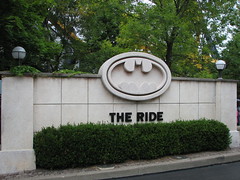 A dialectic runs through my head over whether or not I think Batman is one of B&M’s finest inverted coasters, or simply a scaled-back practice outing that they would later refine and build upon. One part of me (we’ll say it’s my right brain) keeps saying, “Of course it is! This is by far the tightest design they ever made for an inverted coaster, back before they became too dependent on force readouts and still made coasters with some kick to them. Everything else after this design was compromised by taller heights and faster speeds… ergo, more controlled forces and slower timing between elements. It might be small and short, but it’s non-stop and packs the most aggressive punch Bolliger & Mabillard has ever made – or will ever make.”
A dialectic runs through my head over whether or not I think Batman is one of B&M’s finest inverted coasters, or simply a scaled-back practice outing that they would later refine and build upon. One part of me (we’ll say it’s my right brain) keeps saying, “Of course it is! This is by far the tightest design they ever made for an inverted coaster, back before they became too dependent on force readouts and still made coasters with some kick to them. Everything else after this design was compromised by taller heights and faster speeds… ergo, more controlled forces and slower timing between elements. It might be small and short, but it’s non-stop and packs the most aggressive punch Bolliger & Mabillard has ever made – or will ever make.”
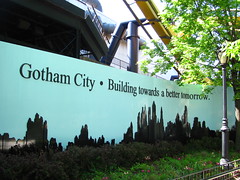 But then the other half of my brain (the left hemisphere) chimes in, “Don’t get too sentimental. While the design of the elements might be tight, that’s only to be canceled out by the extra-small scale and speed. The ride time is short as well, and while it might not be a bad coaster, there are plenty of other inverts built after it that are much more ambitious. The only reason it’s been duplicated so many times is because it’s small, cheap and easily accessible for lazy parks that don’t feel like taking any risks with their design.”
But then the other half of my brain (the left hemisphere) chimes in, “Don’t get too sentimental. While the design of the elements might be tight, that’s only to be canceled out by the extra-small scale and speed. The ride time is short as well, and while it might not be a bad coaster, there are plenty of other inverts built after it that are much more ambitious. The only reason it’s been duplicated so many times is because it’s small, cheap and easily accessible for lazy parks that don’t feel like taking any risks with their design.”
I have more sympathy towards the right hemisphere of my brain, since the left’s argument basically boils down to “bigger is better; clones are bad”, which can easily be defeated. That said, I’ve been on my fair share of Batmen before and my impression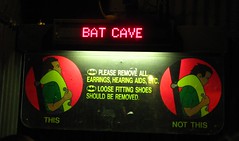 still seems stuck at the phase where I need to ride it more to decide how much I really enjoy it. Not helping is the fact that I can usually only ride it once or twice a year, and the simple struggle it usually is to survive a day in a Six Flags park, with all the long lines and dehydration that normally entails. But if right is right I should have a stronger opinion of the coaster by now, so maybe my left brain is correct and I’m simply transferring my sentimentality for other pre-1998 B&M coasters onto this design. Maybe what I need is a good old fashioned ride analysis written miles away from the nearest working example settle my internal debate.
still seems stuck at the phase where I need to ride it more to decide how much I really enjoy it. Not helping is the fact that I can usually only ride it once or twice a year, and the simple struggle it usually is to survive a day in a Six Flags park, with all the long lines and dehydration that normally entails. But if right is right I should have a stronger opinion of the coaster by now, so maybe my left brain is correct and I’m simply transferring my sentimentality for other pre-1998 B&M coasters onto this design. Maybe what I need is a good old fashioned ride analysis written miles away from the nearest working example settle my internal debate.
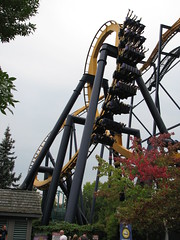 Imagine, if I will… I’m in the front row, ascending the lift; we reach the crest and skirt down the pre-drop before sharply twisting around and down. The narrow radius twisting is cool. I haven’t quite had anything like that on a B&M coaster in a while, but I’m also struck by how short this drop is, pulling up what looks like twenty feet above ground-level when it’s already not much more than 100ft. tall. The first loop is tight and intense, but it also seems to just blow through it fast without providing as much dizzyingly quick fore-and-aft rotation I was expecting. What that means is, picture yourself doing a front-flip on a bungee trampoline: flipping around
Imagine, if I will… I’m in the front row, ascending the lift; we reach the crest and skirt down the pre-drop before sharply twisting around and down. The narrow radius twisting is cool. I haven’t quite had anything like that on a B&M coaster in a while, but I’m also struck by how short this drop is, pulling up what looks like twenty feet above ground-level when it’s already not much more than 100ft. tall. The first loop is tight and intense, but it also seems to just blow through it fast without providing as much dizzyingly quick fore-and-aft rotation I was expecting. What that means is, picture yourself doing a front-flip on a bungee trampoline: flipping around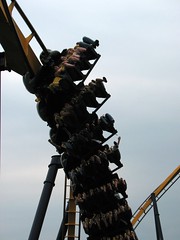 your axis in one second will feel much more intense than if it takes three, even though there’s no added g-forces involved between either scenarios.
your axis in one second will feel much more intense than if it takes three, even though there’s no added g-forces involved between either scenarios.
We pull up, into the zero-g roll (this was the first ever built). Again, in terms of timing it’s very quick, but I still seem to be missing the tight angular momentum.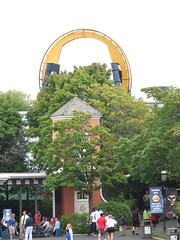 The rolling movement is much more sudden on this than on later versions where they would lead into it more on the incline. There’s also a bit of a ‘snap’ to the roll at the inverting point with an almost imperceptible shimmy to the right, adding a bit extra unpredictability and intensity. Wasting no time, we’re diving back down to set up vertical loop number two, basically a carbon copy of the first
The rolling movement is much more sudden on this than on later versions where they would lead into it more on the incline. There’s also a bit of a ‘snap’ to the roll at the inverting point with an almost imperceptible shimmy to the right, adding a bit extra unpredictability and intensity. Wasting no time, we’re diving back down to set up vertical loop number two, basically a carbon copy of the first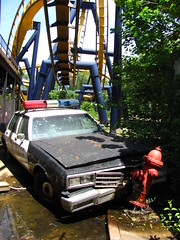 and provides not much in the way of new sensations, but creates a solid, forward-moving loop/roll/loop progression that constitutes the first half of the experience before it switches into the banked turn heavy second half that’s constantly doubling back over and around itself.
and provides not much in the way of new sensations, but creates a solid, forward-moving loop/roll/loop progression that constitutes the first half of the experience before it switches into the banked turn heavy second half that’s constantly doubling back over and around itself.
We slide hard around an upward left helix that diminishes in force. There’s no midcourse brake run on the ride, but in some ways it still nearly feels like it because the high altitude transition from left to right acts as half a placeholder. It’s alright though, because this is one of the best places on the ride to appreciate the feet dangling invertedness (which is particularly important if the year is 1992) and it has a bit of a crescendo at the end as we dive to the right, almost like a second first drop, into the first flat-spin. It whips us around to the right without losing momentum before diving into a trench and continuing up into the second corkscrewing flat-spin. This combo of inversion/turn/inversion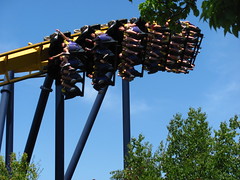 neatly mirrors the first loop/roll/loop progression that was on the opposite side of the slow elevated midpoint, and is easily the nimblest moment of our bat-vehicles. The final left turn starts out with some vigor but finishes weak, a last second denouement of sorts so the brake run that comes less than 40 seconds after cresting the lift doesn’t feel so unexpected.
neatly mirrors the first loop/roll/loop progression that was on the opposite side of the slow elevated midpoint, and is easily the nimblest moment of our bat-vehicles. The final left turn starts out with some vigor but finishes weak, a last second denouement of sorts so the brake run that comes less than 40 seconds after cresting the lift doesn’t feel so unexpected.
However, at the end of each of these rides my right brain had to make a few concessions to my left brain; that while the quick timing between elements is there, by itself that doesn’t accomplish as much as I wish it could. I was hard-pressed to feel much extra force or rotational quickness from the extra small elements. They were simply that: extra small. In many ways the ride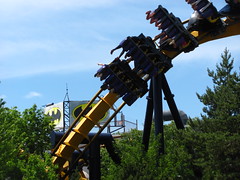 reminds me perfectly of a mini-Raptor, with similar element sequencing and a two-part progression separated by an airy mid-act, but smaller, slower and done sooner. That’s hardly a bad thing. It’s just I couldn’t find anything in its smallness to elevate it above the larger counterparts, it’s only a lesser brother to those rides.
reminds me perfectly of a mini-Raptor, with similar element sequencing and a two-part progression separated by an airy mid-act, but smaller, slower and done sooner. That’s hardly a bad thing. It’s just I couldn’t find anything in its smallness to elevate it above the larger counterparts, it’s only a lesser brother to those rides.
I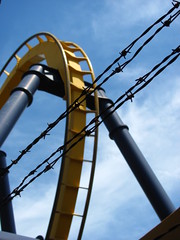 n defense, I’m not a local to any Six Flags park, and I’ve read more than one report from people who are about how their local Batman ride used to go so fast on a hot summer night it looked physically dangerous from off-ride. I’ve never had one of those rides so I can’t comment, but as long as someone qualifies that they did get to experience it when it was running that fast I wouldn’t have a problem if they claim Batman one of B&M’s best. There’s more that can make a great coaster than fast pacing and forcefulness, but if it’s really strong in both of those categories that already is more that can be said than many others. The best thing that I can say about Batman is that at least it’s a consistent ride from beginning to end, with no half-assed helices or s-curves thrown in just to pad out the ending. This is a ride that knows what you want and gives you exactly that with nothing deluxe sprinkled on the top.
n defense, I’m not a local to any Six Flags park, and I’ve read more than one report from people who are about how their local Batman ride used to go so fast on a hot summer night it looked physically dangerous from off-ride. I’ve never had one of those rides so I can’t comment, but as long as someone qualifies that they did get to experience it when it was running that fast I wouldn’t have a problem if they claim Batman one of B&M’s best. There’s more that can make a great coaster than fast pacing and forcefulness, but if it’s really strong in both of those categories that already is more that can be said than many others. The best thing that I can say about Batman is that at least it’s a consistent ride from beginning to end, with no half-assed helices or s-curves thrown in just to pad out the ending. This is a ride that knows what you want and gives you exactly that with nothing deluxe sprinkled on the top.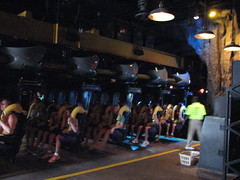
An added feature that I really liked about Six Flags Great America’s version is there are some close calls with nearby trees and shrubs. Particularly on the descent down into the first corkscrew and immediately after the second corkscrew on the final turn, the plant life nearly enfolds the trains on all sides. Someone tall enough might even be able to kick some of the branches if they really reach for it. I don’t believe any other Batman layout has anything quite as confrontational; combined with the more natural setting that fits with the park, I think this first Batman probably is the best of all the versions ever manufactured since its debut in 1992. More than twenty years later it’s still possibly the best looping coaster in the Chicago area. That has to count for something.
I agree with your feelings about the more natural setting. My home Six Flags park used to be Great Adventure when I grew up in/lived in New York. I always associated gravel, weeds, and spare-parts storage with the areas underneath Batman (and pretty much all the coasters at Great Adventure.) Mind you, that’s pretty sad given Great Adventure’s highly wooded, secluded setting.
I live in Chicago now and when I finally visited SF Great America, I was stunned what a difference it makes for a theme park to make friends with its natural setting. (Well, not so natural since Great America was built from scratch in the middle of the ‘burbs, but you get my meaning.) Batman over grass and through trees and shrubs feels more intense and complete than the version I knew at Great Adventure.
That goes for all of Great America for me, really. It’s still Six Flags, so shallow theming and theme elements left to die (i.e. Dark Knight, etc.) are still there. But GAm is definitely a park that knows how to use its setting to good advantage.
After all, see: Whizzer 🙂
It is a surprising reversal… Great Adventure had a nice, natural setting which has largely been squandered over the past years, while Great America started on a flat square site next to the highway and has grown in with vegetation quite nicely. If you only focus on the big coasters at Great Adventure, however, you’re likely to miss a few pleasant areas. One is the secluded trail over the river and through the woods under the mine train from El Toro to Bizarro, and they also have a nice use of the lakefront over by the aquatic stadium with a nearby short section of pathways through the trees that almost resembles something from Knoebels. I think the big difference is that Great America didn’t see as aggressive expansion during the Premier Parks days as Great Adventure did.